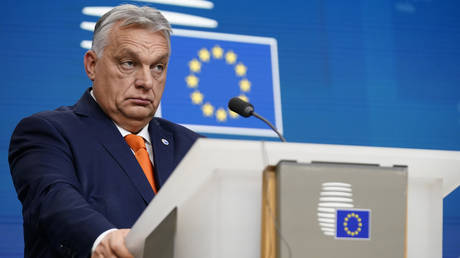Federal Reserve Chair Jerome Powell.
Kent Nishimura/Getty Images
Fed Chair Jerome Powell said that he expects interest rates to stay higher for longer.He said his confidence that inflation will slow “is not as high as it was.”Still, the slowing job market is a sign that the economy is moving in the right direction.
Inflation and interest rates are still high, but Americans shouldn’t count on any relief just yet.
Since July 2023, the Federal Reserve has held interest rates steady as it continues to work toward its 2% inflation target, and it looks like rates might stay the same for longer than previously expected.
The year-over-year increase in the Consumer Price Index, which measures inflation, came in at 3.4% in April, per a news release from the Bureau of Labor Statistics out Wednesday. That’s just below March’s 3.5% increase and shows that despite the slight cooling, inflation is still remaining stubbornly high. Core CPI, which excludes food and energy prices, increased 3.6% from April 2023 to this past April, a small dip from the 3.8% year-over-year rise in March.
Mark Hamrick, Bankrate senior economic analyst, said in a statement that those rates “remain irritatingly high.”
“The status of the battle against inflation requires that interest rates remain elevated in the near-term,” Hamrick said.
Fed Chair Jerome Powell elaborated on the implications of this year’s inflation readings during a Tuesday panel discussion in Amsterdam. While his comments were before Wednesday’s release, his message is still relevant: Americans should get used to interest rates being higher for longer until the Fed feels confident enough that inflation is moving in the right direction.
“The first quarter in the United States was notable for its lack of further progress on inflation,” Powell said during the panel.
“We did not expect this to be a smooth road, but these were higher than I think anybody expected,” Powell added. “What that has told us is that we’ll need to be patient and let restrictive policy do its work.”
He added that his confidence that inflation will slow “is not as high as it was, having seen these readings in the first three months of the year.”
While the Federal Open Market Committee projected three interest rate cuts for 2024 in December, it’s looking more likely cuts will not happen until the second half of this year, at the earliest. Still, Powell maintained on Tuesday that the most likely outcome is that the Fed will just continue to hold rates steady.
Survey results highlight how consumers are feeling about inflation and the overall economy. University of Michigan Surveys of Consumers data published this past Friday shows consumers are feeling pretty gloomy about the economy; the results also imply that Americans are still worried about inflation.
“Year-ahead inflation expectations rose from 3.2% last month to 3.5% this month, remaining above the 2.3-3.0% range seen in the two years prior to the pandemic,” Surveys of Consumers Director Joanne Hsu said.
Markets and investors, based off the CME FedWatch Tool as of Wednesday afternoon, think there’s roughly a 10% chance of a cut in June, a one in three chance by July, and a roughly three-quarters chance by September.
The economy is settling down
Data about the labor market and spending show the US economy is robust but slowing into a steady groove.
Powell said policy is weighing on the labor market and interest-rate-sensitive spending, and said the Fed’s “policy is the highest it’s been in quite some time.”
Job growth has moderated. There were 175,000 jobs added in April, far below the gains seen earlier this year. But while job seekers and workers may find this cooldown concerning, that moderation is also welcome and the labor market is still strong.
“Compared to expectations, definitely was a disappointing report,” Nick Bunker, the economic research director for North America at the Indeed Hiring Lab, told Business Insider. “But, I think if the underlying trend in the labor market is toward moderation, you’re going to have reports like this from time to time that come in a little bit weaker than expected or what you’d want to see.”
New data out Wednesday showed the change in retail and food services sales from March to April was flat after a 0.6% increase in March and a 0.7% increase just before that in February. The year-over-year change in April was also less than the change in March — 3.0% in April versus 3.8% in March.
Ted Rossman, senior industry analyst at Bankrate, told Business Insider that while the retail sales numbers weren’t stellar, they are also far from being disastrous.
Rossman said spending has “remained surprisingly strong” and that if consumers are beginning to pull back on their spending, that could perhaps be “a good decision at the household level.”
“It’s not necessarily great for the economy, but hey, we don’t want you to be in credit card debt at that average interest rate over 20%,” Rossman said. “So, maybe the fact that people are eating out a little bit less and they’re pulling back on bigger ticket purchases like furniture and cars, maybe that’s a good rational thing in the long run.”
Elizabeth Renter, a data analyst at NerdWallet, said in recent commentary that some “consumers may be pulling back slightly on spending, and who can blame them?”
“Paired with high borrowing costs — like high interest rates on your credit cards — and the current economy can feel quite uncomfortable,” Renter added.
So, while Americans are likely on track for higher interest rates longer than they might have hoped, Powell said on Tuesday that it’s not all bad, and things are gradually moving in the right direction.
“At the beginning, we were very concerned that the very high inflation we saw might be quite difficult to bring down without a very significant decline in employment and weakening economic activity,” Powell said on Tuesday. “That didn’t happen, that’s just a great result.”





+ There are no comments
Add yours